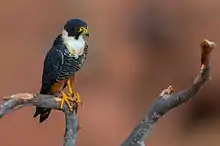Bat falcon
The bat falcon (Falco rufigularis) is a falcon that is a resident breeder in tropical Mexico, Central and South America, and Trinidad. It was long known as Falco albigularis; the names Falco fusco-coerulescens or Falco fuscocaerulescens, long used for the aplomado falcon, are now believed to refer to the present species.[2]
| Bat falcon | |
|---|---|
 | |
| Scientific classification | |
| Kingdom: | Animalia |
| Phylum: | Chordata |
| Class: | Aves |
| Order: | Falconiformes |
| Family: | Falconidae |
| Genus: | Falco |
| Species: | F. rufigularis |
| Binomial name | |
| Falco rufigularis Daudin, 1800 | |
 | |
| Synonyms | |
| |
The female bat falcon, at 30.5 cm length, is much larger than the 23-cm-long male. Adults have a black back, head, and tail. The throat, upper breast, and neck sides are creamy white, the lower breast and belly are black, finely barred white, and the thighs and lower belly are orange. Young birds are similar, but with a buffy throat. The call of this species is a high pitched ke-ke-ke like the American kestrel.
It is probably closely related to and looks like a small version of the orange-breasted falcon. These two, in turn, are probably closest to the aplomado falcon and constitute a rather old American lineage of Falco species.[3]
This small dark bird of prey inhabits open woodlands and forest clearings. Bat falcons perch conspicuously on high, open snags, from which they launch aerial attacks on their prey. They hunt bats, birds, small rodents and large insects such as dragonflies. The smaller male takes more insects, and the female more birds and bats. The flight is direct and powerful. This falcon is partly crepuscular, as the bats in its diet suggest. It lays two or three brown eggs in an unlined treehole nest.
Notes
- BirdLife International (2012). "Falco rufigularis". IUCN Red List of Threatened Species. 2012. Retrieved 26 November 2013.CS1 maint: ref=harv (link)
- American Ornithologists' Union (1948). "Twenty-third supplement to the American Ornithologists' Union check-list of North American birds" (PDF). Auk. 65 (3): 438–443. doi:10.2307/4080493. JSTOR 4080493.
- Probably diverging from their relatives some 8-5 million years ago, during the Late Miocene. See Birregard (1994), Helbig et al. (1994), Wink et al. (1998), Griffiths (1999), Groombridge et al. (2002), Griffiths et al. (2004)
References
- Beebe, C. William (1950): The home life of the bat falcon, Falco albigularis Daudin. Zoologica (New York) 35(4): 69–86.
- Birregard, Richard O. (1994): 45. Bat Falcon. In: del Hoyo, Josep; Elliott, Andrew & Sargatal, Jordi (editors): Handbook of Birds of the World, Volume 2 (New World Vultures to Guineafowl): 267–268, plate 27. Lynx Edicions, Barcelona. ISBN 84-87334-15-6
- ffrench, Richard; O'Neill, John Patton & Eckelberry, Don R. (1991): A guide to the birds of Trinidad and Tobago (2nd edition). Comstock Publishing, Ithaca, N.Y.. ISBN 0-8014-9792-2
- Hilty, Steven L. (2003): Birds of Venezuela. Christopher Helm, London. ISBN 0-7136-6418-5
- Helbig, A.J.; Seibold, I.; Bednarek, W.; Brüning, H.; Gaucher, P.; Ristow, D.; Scharlau, W.; Schmidl, D. & Wink, Michael (1994): Phylogenetic relationships among falcon species (genus Falco) according to DNA sequence variation of the cytochrome b gene. In: Meyburg, B.-U. & Chancellor, R.D. (editors): Raptor conservation today: 593–599. PDF fulltext
- Griffiths, Carole S. (1999): Phylogeny of the Falconidae inferred from molecular and morphological data. Auk 116(1): 116–130. PDF fulltext
- Griffiths, Carole S.; Barrowclough, George F.; Groth, Jeff G. & Mertz, Lisa (2004). "Phylogeny of the Falconidae (Aves): a comparison of the efficacy of morphological, mitochondrial, and nuclear data". Molecular Phylogenetics and Evolution. 32 (1): 101–9. doi:10.1016/j.ympev.2003.11.019. PMID 15186800.
- Groombridge, Jim J.; Jones, Carl G.; Bayes, Michelle K.; van Zyl, Anthony J.; Carrillo, José; Nichols, Richard A. & Bruford, Michael W. (2002). "A molecular phylogeny of African kestrels with reference to divergence across the Indian Ocean". Molecular Phylogenetics and Evolution. 25 (2): 267–77. doi:10.1016/S1055-7903(02)00254-3. PMID 12414309.
- Wink, Michael; Seibold, I.; Lotfikhah, F. & Bednarek, W. (1998): Molecular systematics of holarctic raptors (Order Falconiformes). In: Chancellor, R.D., Meyburg, B.-U. & Ferrero, J.J. (editors): Holarctic Birds of Prey: 29–48. Adenex & WWGBP. PDF fulltext
External links
- Bat Falcon videos on the Internet Bird Collection
- Stamps (for Suriname) with RangeMap
- Bat Falcon photo gallery VIREO Photo-High Res
- Photo-Medium Res; Article oiseaux
